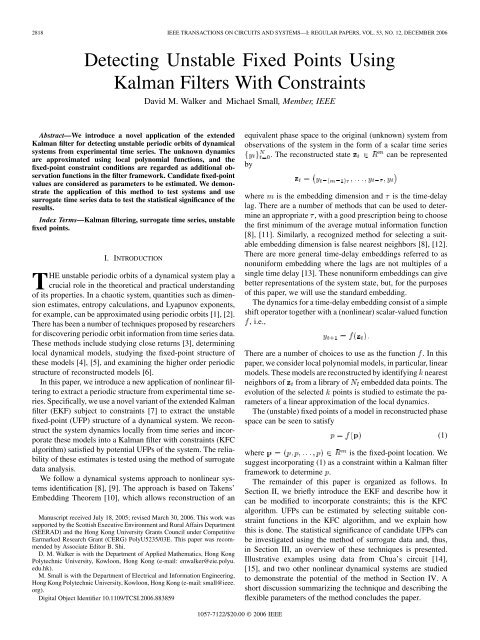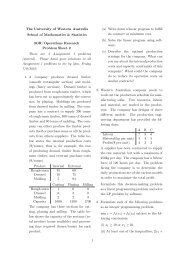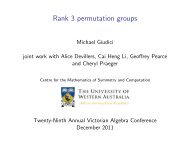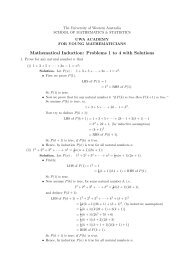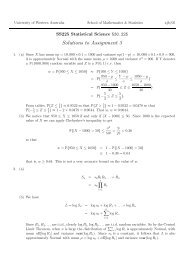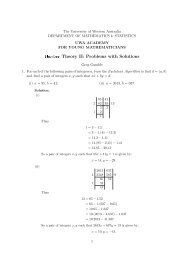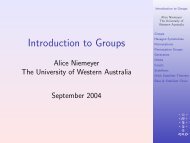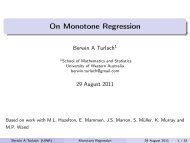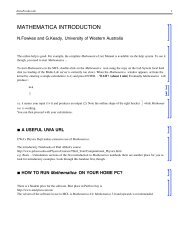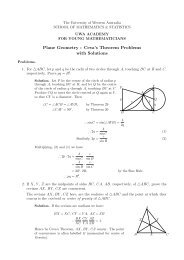Detecting Unstable Fixed Points Using Kalman Filters ... - IEEE Xplore
Detecting Unstable Fixed Points Using Kalman Filters ... - IEEE Xplore
Detecting Unstable Fixed Points Using Kalman Filters ... - IEEE Xplore
Create successful ePaper yourself
Turn your PDF publications into a flip-book with our unique Google optimized e-Paper software.
2818 <strong>IEEE</strong> TRANSACTIONS ON CIRCUITS AND SYSTEMS—I: REGULAR PAPERS, VOL. 53, NO. 12, DECEMBER 2006<strong>Detecting</strong> <strong>Unstable</strong> <strong>Fixed</strong> <strong>Points</strong> <strong>Using</strong><strong>Kalman</strong> <strong>Filters</strong> With ConstraintsDavid M. Walker and Michael Small, Member, <strong>IEEE</strong>Abstract—We introduce a novel application of the extended<strong>Kalman</strong> filter for detecting unstable periodic orbits of dynamicalsystems from experimental time series. The unknown dynamicsare approximated using local polynomial functions, and thefixed-point constraint conditions are regarded as additional observationfunctions in the filter framework. Candidate fixed-pointvalues are considered as parameters to be estimated. We demonstratethe application of this method to test systems and usesurrogate time series data to test the statistical significance of theresults.Index Terms—<strong>Kalman</strong> filtering, surrogate time series, unstablefixed points.I. INTRODUCTIONTHE unstable periodic orbits of a dynamical system play acrucial role in the theoretical and practical understandingof its properties. In a chaotic system, quantities such as dimensionestimates, entropy calculations, and Lyapunov exponents,for example, can be approximated using periodic orbits [1], [2].There has been a number of techniques proposed by researchersfor discovering periodic orbit information from time series data.These methods include studying close returns [3], determininglocal dynamical models, studying the fixed-point structure ofthese models [4], [5], and examining the higher order periodicstructure of reconstructed models [6].In this paper, we introduce a new application of nonlinear filteringto extract a periodic structure from experimental time series.Specifically, we use a novel variant of the extended <strong>Kalman</strong>filter (EKF) subject to constraints [7] to extract the unstablefixed-point (UFP) structure of a dynamical system. We reconstructthe system dynamics locally from time series and incorporatethese models into a <strong>Kalman</strong> filter with constraints (KFCalgorithm) satisfied by potential UFPs of the system. The reliabilityof these estimates is tested using the method of surrogatedata analysis.We follow a dynamical systems approach to nonlinear systemsidentification [8], [9]. The approach is based on Takens’Embedding Theorem [10], which allows reconstruction of anManuscript received July 18, 2005; revised March 30, 2006. This work wassupported by the Scottish Executive Environment and Rural Affairs Department(SEERAD) and the Hong Kong University Grants Council under CompetitiveEarmarked Research Grant (CERG) PolyU5235/03E. This paper was recommendedby Associate Editor B. Shi.D. M. Walker is with the Department of Applied Mathematics, Hong KongPolytechnic University, Kowloon, Hong Kong (e-mail: enwalker@eie.polyu.edu.hk).M. Small is with the Department of Electrical and Information Engineering,Hong Kong Polytechnic University, Kowloon, Hong Kong (e-mail: small@ieee.org).Digital Object Identifier 10.1109/TCSI.2006.883859equivalent phase space to the original (unknown) system fromobservations of the system in the form of a scalar time series. The reconstructed state can be representedbywhere is the embedding dimension and is the time-delaylag. There are a number of methods that can be used to determinean appropriate , with a good prescription being to choosethe first minimum of the average mutual information function[8], [11]. Similarly, a recognized method for selecting a suitableembedding dimension is false nearest neighbors [8], [12].There are more general time-delay embeddings referred to asnonuniform embedding where the lags are not multiples of asingle time delay [13]. These nonuniform embeddings can givebetter representations of the system state, but, for the purposesof this paper, we will use the standard embedding.The dynamics for a time-delay embedding consist of a simpleshift operator together with a (nonlinear) scalar-valued function, i.e.,There are a number of choices to use as the function . In thispaper, we consider local polynomial models, in particular, linearmodels. These models are reconstructed by identifying nearestneighbors of from a library of embedded data points. Theevolution of the selected points is studied to estimate the parametersof a linear approximation of the local dynamics.The (unstable) fixed points of a model in reconstructed phasespace can be seen to satisfywhereis the fixed-point location. Wesuggest incorporating (1) as a constraint within a <strong>Kalman</strong> filterframework to determine .The remainder of this paper is organized as follows. InSection II, we briefly introduce the EKF and describe how itcan be modified to incorporate constraints; this is the KFCalgorithm. UFPs can be estimated by selecting suitable constraintfunctions in the KFC algorithm, and we explain howthis is done. The statistical significance of candidate UFPs canbe investigated using the method of surrogate data and, thus,in Section III, an overview of these techniques is presented.Illustrative examples using data from Chua’s circuit [14],[15], and two other nonlinear dynamical systems are studiedto demonstrate the potential of the method in Section IV. Ashort discussion summarizing the technique and describing theflexible parameters of the method concludes the paper.(1)1057-7122/$20.00 © 2006 <strong>IEEE</strong>
WALKER AND SMALL: DETECTING UNSTABLE FIXED POINTS USING KALMAN FILTERS WITH CONSTRAINTS 2821Fig. 1. x versus t for the Chua circuit. The horizontal lines indicate the locationof the (unstable) fixed points.Wereservethefirst embeddeddatapointstobeusedas a library for reconstructing the local linear models and applythe KFC to the next 1000 time-series values. For the given embeddingdimension, we selected a value of as the numberof nearest neighbors to use in the local reconstructions. We useda sliding window of length and consideredfixed-point constraints. The assumed constraint error covariancefor each fixed point was set to. The assumednoise levels for the dynamics was set to , where isthe standard deviation of the time-series data. The observationalnoise covariance and the initial error covariance for thestate and fixed-point estimates were set to .We note that all of these parameters are tunable, and so there isgreat flexibility in applying the KFC for UFP detection.In Fig. 2, we show a plot of against for eachcandidate fixed point and sliding window. A histogram of themore meaningful estimates are shown in Fig. 3, where onlythose points withare considered. We can seethat there are two large peaks centered about the known UFPsat . The UFP at the origin is not so prominent. The reliabilityof these estimates can be tested using surrogate data.In Fig. 4, we compare the estimated UFPs for the doublescroll data in Fig. 1 to the same calculation of candidate UFPsfor linear surrogate time series. In each case, the linear surrogatetime series exhibit only a peak in the distribution of UFPs (foralgorithms 1 and 2) at 0. There is no indication of false identificationof nonzero UFPs. This is to be expected.Fig. 5 repeats the calculation of Fig. 4 for nonlinear surrogatesgenerated using the PPS algorithm described in [22]. In this case,we expect the surrogates to exhibit similar distributions of UFPsas the data. This is precisely what we observe. The three calculationsin Fig. 5 are for three distinct levels of dynamic noise in thesurrogates. For the lowest level of noise (the top panel of Fig. 5),the distribution of candidate UFPs is very close to that estimatedfrom the data: both data and surrogates exhibit almost the samedynamics and therefore the same UFPs. For increasing levels ofdynamicnoise, thedistinctionbecomesmorepronounced.This isFig. 2. Plot of p versus log(v ) for data from Chua’s circuit. There appearsto be accumulations about 6r for small values of v .Fig. 3. Histogram of the candidate UFPs for which log(vare definite peaks about the known UFPs at 6r.) < 0:5. Thereconsistent with the results described in [25]: as the dynamic noiselevel increases, the PPS surrogates only reproduce the macroscopicdeterministic dynamics of the data.As a second example, we consider Chen’s equations whichcan be realized as an electronic circuit [26]
2822 <strong>IEEE</strong> TRANSACTIONS ON CIRCUITS AND SYSTEMS—I: REGULAR PAPERS, VOL. 53, NO. 12, DECEMBER 2006Fig. 4. Linear surrogate data calculations: the left-hand panels show typical surrogate data generated from the time series in Fig. 1, and the right-hand panels arethe histogram of candidate UFPs [as in Fig. 3, they are overlaid with the ensemble of histograms for 30 surrogates (dotted lines) and an average of that ensemble(solid lines)]. From top to bottom, the three rows are the results for linear surrogates consistent with Algorithms 0, 1, and 2, respectively.The parametersgive rise to achaotic attractor, and there are three fixed points at, , andwhere. We usea time series of the variable to detect the UFPs with ourmethod. In Fig. 6 (upper left panel), the time series and locationof the theoretical fixed points are shown. We embedded thetime series in four dimensions with a time-delay lag of 10 andused neighbors to reconstruct the local linear modelsfrom a library of 1500 points. We set and used a datapresentation window of points. The noise parametersof the <strong>Kalman</strong> filter and were set as in the Chua circuitexample, but . The left middle and left lower panels ofFig. 6 show the equivalent plots of Figs. 2 and 3 but, in thiscase, we show the histogram for. We note thatthe three UFPs are apparent as spikes in the histogram, but theyare not as prominent as seen in the Chua circuit example. Theright panels of Fig. 6 show the results of applying the surrogatemethods Algorithms 0, 1, and 2 to the data. We see clearly thatthe peaks corresponding to the identified UFPs are significant.
WALKER AND SMALL: DETECTING UNSTABLE FIXED POINTS USING KALMAN FILTERS WITH CONSTRAINTS 2823Fig. 5. Nonlinear PPS surrogate data calculations: the left-hand panels show typical surrogate data generated from the time series in Fig. 1, and the right-handpanels are the histogram of candidate UFPs [as in Fig. 3, they are overlaid with the ensemble of histograms for 30 surrogates (dotted lines) and an average of thatensemble (solid line)]. From top to bottom, the three rows are the results for PPS algorithm with value of randomization ranging from small (top) to large (bottom).Our third and final example is a system of ordered differentialequations (ODEs) derived from an electronic circuit of Rulkovand colleagues [27]. The circuit equations are [28]where , , , and . Thenonlinear functionwhereififif
2824 <strong>IEEE</strong> TRANSACTIONS ON CIRCUITS AND SYSTEMS—I: REGULAR PAPERS, VOL. 53, NO. 12, DECEMBER 2006Fig. 6. Left panels from top to bottom show the Chen time series with UFP locations, the candidate fixed points plotted against the distance measure log(jv j),and those same candidate UFPs displayed as a histogram. The right panels show the significance of the identified fixed points when tested against 30 surrogatedata sets using Algorithm 0, 1, and 2 (top to bottom).We use the parameters in [28] which gives rise to a chaoticattractor. That is, , ,with , , and . In this example, we usedthe same parameters as in the previous Chen circuit exampleexcept that we show the histograms of detected UFPs for. The results are shown in Fig. 7, and onceagain we see that our algorithm has located three significantcandidate fixed points as verified using the surrogate datasets.V. SUMMARYIn this paper, we have presented a novel application of nonlinearfiltering to detect the low-order periodic structure of dynamicalsystems. The method uses a modification of the EKF,which incorporates fixed-point properties as constraints withinthe observation model of the filter. The local dynamics of thesystem are estimated using linear models reconstructed at eachtime-update step of the filter using a library of embedded data
WALKER AND SMALL: DETECTING UNSTABLE FIXED POINTS USING KALMAN FILTERS WITH CONSTRAINTS 2825Fig. 7. Left panels from top to bottom show the Rulkov circuit time series with UFP locations, the candidate fixed points plotted against the distance measurelog(jv j), and those same candidate UFPs displayed as a histogram. The right panels show the significance of the identified fixed points when tested against 30surrogate data sets using Algorithms 0, 1, and 2 (top to bottom).points. The local models are subsequently used in the measurement-updatestep of the KFC to estimate candidate UFPs.It was found that applying the KFC to a sliding window of thetime-series data was a practical way of extracting the requiredestimates of the dynamical information. The method of surrogatedata analysis was used to determine the significance of thedetected fixed points.The algorithm is most closely related to the method introducedby Glover and Mees [4], where fixed points of localmodels using neighboring data points in time are estimatedto find candidate UFPs of the nonlinear system. We alsoreconstruct local models but use neighboring data points inembedded space, which may be more robust to noisy timeseries. Furthermore, the <strong>Kalman</strong> filter also produces a filteredsystem state that may produce better results for noisy data.We followed the good practice in [5] and [6] and investigatedthe significance of the candidate UFPs using surrogate timeseries, however, we did not find it necessary to transform the
2826 <strong>IEEE</strong> TRANSACTIONS ON CIRCUITS AND SYSTEMS—I: REGULAR PAPERS, VOL. 53, NO. 12, DECEMBER 2006Fig. 8. These panels clockwise from top left show the dependence of the UFP locations determined from the Chua circuit time series on some of the tunableparameters in the KFC, that is, the dynamical noise level Q, the observational noise level R, the constraint noise level R , and the number of constraints N .Each parameter was varied one at a time, keeping the others fixed at the nominal values used earlier in the text, so that only first-order effects can be seen. (Thehistograms have all been normalized to aid the comparison.) We see that, once suitable embedding parameters are selected, the KFC algorithm is quite robust withrespect to the tunable filter parameters.embedded data with respect to the locally reconstructed modelsto extract the fixed-point information. In principle, we couldhave carried out the same transformations as in [5] and in [6]using the <strong>Kalman</strong> filter estimates of the system state. Onceagain, we might anticipate that these noise-reduced estimatescould help in high-noise cases.Our use of the KFC algorithm for detecting fixed points andsimultaneously producing filtered state estimates is similar inapplication to that of <strong>Kalman</strong>-filter-based parameter fitting [29].In such an application, the extended <strong>Kalman</strong> filter becomes thebasis of a recursive second-order optimization method since theEKF approximates the second-order covariance matrix and sois an alternative to standard backpropagation. As such, the KFCfor fixed-point detection can be thought of as a gradient descentalgorithm, and an interesting future research topic would be toinvestigate this comparison more fully.The algorithm has many tunable parameters which are listedin Table I. This may be seen as a drawback of the method, butit does allow great flexibility to tune the algorithm to potentiallyperform well in difficult circumstances such as high-noisecases. The number of flexible parameters shown in Table I canbe reduced somewhat. For example, the four parameters markedTABLE ITUNABLE PARAMETERS OF THE KFC UFP DETECTION METHODas “Dynamics” can be determined by following the well-establishedprescriptions described in [8]. Once suitable embeddingparameters and good local models have been reconstructed, weimagine these to be fixed, leaving only the tunable parametersof the <strong>Kalman</strong> filter to be flexible.
WALKER AND SMALL: DETECTING UNSTABLE FIXED POINTS USING KALMAN FILTERS WITH CONSTRAINTS 2827We have carried out a (numerical) first-order sensitivityanalysis of the tunable <strong>Kalman</strong> filter parameters; the dynamicalnoise level , the observational noise level , and the new constraintnoise level together with the number of constraints, by varying each one at a time about nominal values (thoseused in the example) for the Chua circuit data set. The resultsare shown in Fig. 8. We see that, for a given set of “dynamics”parameters, the KFC algorithm is quite robust to the varioustunable parameters of the filter.ACKNOWLEDGMENTOne of the authors, D. M. Walker, would like to thank Biomathematics& Statistics Scotland for accommodations wheremost of the work for this paper was carried out.REFERENCES[1] R. Artuso, E. Aurell, and P. Cvitanović, “Recycling of strange sets: I.cycle expansions,” Nonlinearity, vol. 3, p. 325, 1990.[2] ——, “Recycling of strange sets: II. Applications,” Nonlinearity, vol.3, p. 361, 1990.[3] D. Auerbach, P. Cvitanović, J.-P. Eckmann, and G. Gunaratne, “Exploringchaotic motion through periodic orbits,” Phys. Rev. Lett., vol.58, no. 23, pp. 2387–2389, 1987.[4] J. Glover and A. Mees, “Reconstructing the dynamics of Chua’s circuit,”J. Circuits, Syst., Comput., vol. 3, no. 1, pp. 201–214, 1993.[5] P. So, E. Ott, S. J. Schiff, D. T. Kaplan, T. Sauer, and C. Grebogi,“<strong>Detecting</strong> unstable periodic orbits in chaotic experimental data,” Phys.Rev. Lett., vol. 76, no. 25, pp. 4705–4708, 1996.[6] P. So, E. Ott, T. Sauer, B. J. Gluckman, C. Grebogi, and S. J. Schiff,“Extracting unstable periodic orbits from chaotic time series data,”Phys. Rev. E, vol. 55, no. 5, pp. 5398–5417, 1997.[7] D. M. Walker, “Parameter estimation using <strong>Kalman</strong> filters with constraints,”Int. J. Bifurc. Chaos, vol. 16, no. 4, pp. 1067–1078, 2006.[8] H. D. I. Abarbanel, Analysis of Observed Chaotic Data. Berlin, Germany:Springer-Verlag, 1995.[9] H. Kantz and T. Schrieber, Nonlinear Time Series Analysis. Cambridge,U.K.: Cambridge Univ. Press, 1997.[10] F. Takens, “<strong>Detecting</strong> strange attractors in turbulence,” in DynamicalSystems and Turbulence, Warwick 1980, D. Rand and L. S. Young,Eds. Berlin, Germany: Springer-Verlag, 1981, p. 366.[11] A. M. Fraser and H. L. Swinney, “Independent coordinates for strangeattractors from mutual information,” Phys. Rev. A, vol. 33, no. 2, pp.1134–1140, 1986.[12] M. B. Kennel, R. Brown, and H. D. I. Abarbanel, “Determining embeddingdimension for phase-space reconstruction using a geometricalconstruction,” Phys. Rev. A, vol. 45, no. 6, pp. 3402–3411, 1992.[13] K. Judd and A. Mees, “Embedding as a modeling problem,” PhysicaD, vol. 120, no. 3–4, pp. 273–286, 1998.[14] R. N. Madan, Chua’s Circuit: A Paradigm for Chaos. Singapore:World Scientific, 1993.[15] M. P. Kennedy, “Robust op amp realization of Chua’s circuit,” Frequenz,vol. 40, no. 3–4, pp. 55–80, 1993.[16] O. L. R. Jacobs, Introduction to Control Theory, 2nd ed. Oxford,U.K.: Oxford Science, 1993.[17] D. M. Walker and A. I. Mees, “Noise reduction of chaotic systems by<strong>Kalman</strong> filtering and by shadowing,” Int. J. Bifurc. Chaos, vol. 7, no.3, pp. 769–779, 1997.[18] S. Haykin, Ed., <strong>Kalman</strong> Filtering and Neural Networks. New York:Wiley, 2001.[19] D. M. Walker, “Local filtering of noisy nonlinear time series,” Phys.Lett. A, vol. 249, pp. 209–217, 1998.[20] D. M. Walker and A. I. Mees, “Recontructing nonlinear dynamics byextended <strong>Kalman</strong> filtering,” Int. J. Bifurc. Chaos, vol. 8, no. 3, pp.557–569, 1998.[21] J. Theiler, S. Eubank, A. Longtin, B. Galdrikian, and J. Doyne Farmer,“Testing for nonlinearity in time series: the method of surrogate data,”Physica D, vol. 58, pp. 77–94, 1992.[22] M. Small, D. Yu, and R. G. Harrison, “A surrogate test for pseudoperiodictime series data,” Phys. Rev. Lett., vol. 87, p. 188101, 2001.[23] M. Small and C. K. Tse, “<strong>Detecting</strong> determinism in time series: Themethod of surrogate data,” <strong>IEEE</strong> Trans. Circuits Syst. I, Fundam.Theory Appl., vol. 50, no. 5, pp. 663–672, May 2003.[24] M. Small, Applied Nonlinear Time Series Analysis: Applications inPhysics, Physiology and Finance. Singapore: World Scientific, 2005,vol. 52, Nonlinear Science Series A.[25] M. Small and C. K. Tse, “Applying the method of surrogate data tocyclic time series,” Physica D, vol. 164, pp. 187–201, 2002.[26] G. Chen and T. Ueta, “Yet another chaotic attractor,” Int. J. Bifurc.Chaos, vol. 9, pp. 1465–1466, 1999.[27] N. F. Rulkov and A. R. Volkovskii, “Use of one-dimensional mappingsfor an experimental study of the stochastic dynamics of an oscillator,”Sov. Tech. Phys. Lett., vol. 14, p. 656, 1988.[28] H. D. I. Abarbanel, L. Korzinov, A. I. Mees, and I. M. Starobinets,“Optimal control of nonlinear systems to given orbits,” Syst. ControlLett., vol. 31, pp. 263–276, 1997.[29] G. V. Puskorius and L. A. Feldkamp, “Parameter-based <strong>Kalman</strong> filtertraining: Theory and implementation,” in <strong>Kalman</strong> Filtering and NeuralNetworks, S. Haykin, Ed. New York: Wiley, 2001.David M. Walker received the B.Sc. (Hons) degreein joint mathematics–physics from the University ofAberdeen, Aberdeen, U.K., in 1992, the M.Math. degreein applied mathematics from the University ofWaterloo, Waterloo, ON, Canada, in 1994, and thePh.D. degree in applied mathematics from the Universityof Western Australia, Perth, in 1999.He is presently a Research Fellow with the Departmentof Applied Mathematics, Hong Kong PolytechnicUniversity, Kowloon, Hong Kong. He was aSenior Biomathematician with Biomathematics andStatistics Scotland and has held research posts with the University of WesternAustralia, the College of William and Mary, and Hewlett-Packard Laboratories.His research interests are topics in nonlinear dynamics and control. Recently,his work has included application of stochastic modeling, inference, and simulationto problems encountered in complex interacting biological and ecologicalprocesses.Michael Small (M’01) received the B.Sc. (Hons)degree in pure mathematics and the Ph.D. degreein applied mathematics from the University ofWestern Australia, Perth, Australia, in 1994 and1998, respectively.He is presently an Associate Professor in the Departmentof Electronic and Information Engineering,Hong Kong Polytechnic University, Kowloon, HongKong. Previously, he was with the Physics Department,Heriot-Watt University, Edinburgh, U.K., andthe Mathematics Department, University of WesternAustralia. His research interests are nonlinear dynamics and chaos, nonlineartime-series analysis, and nonlinear modeling. As well as modeling disease epidemics,his recent work has been on the application of nonlinear mathematicalmethods to a diverse range of problems, including infant respiratory patterns,cardiac arrhythmia, pulse diagnosis, digital communication systems, and financialtime-series analysis.


